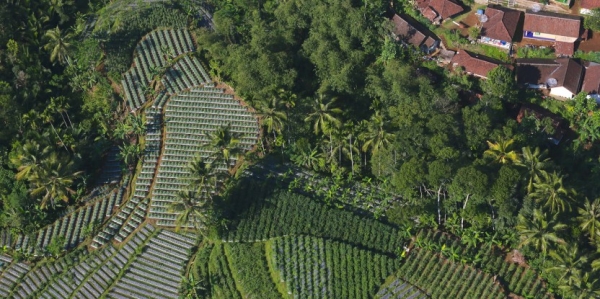Farms vs. forests? A more nuanced look at agrarian change

Forests are being converted into agricultural land throughout the tropics, from Borneo to the Congo Basin. But this process – called agrarian change – can bring communities benefits as well as consequences.
Questions about the benefits and trade-offs of agrarian transitions are too often reduced into a simple debate over how best to increase agricultural production while minimizing deforestation.
“When you’re looking at patterns of agrarian change you need to consider all kinds of other things, not just agricultural production, but livelihoods, diets, ecosystem services,” said Terry Sunderland, a Principal Scientist with theCenter for International Forestry Research (CIFOR).
Sunderland and his colleagues lead the Agrarian Change in Tropical Landscapes project, which aims to get a more comprehensive understanding of the social and economic consequences of the agrarian transition.
The project uses multiple sites in each of six countries.
“One of the strengths of the project is that we’re using this diversity of landscapes, both to come up with some generalized patterns but also to understand the importance of local context,” said Sunderland.
“And I think one big message that stands out is that context is really important.”
Expanding the debateThe Agrarian Change project takes as its premise the need to increase global food production to feed a growing global population. For many tropical landscapes, this will likely require a continued agrarian transition.
“Agriculture monocultures are becoming a more and more dominant land use, in part to address the challenge of growing more food. One way that’s going to happen is by transforming landscapes with tree cover and making them primarily agricultural landscapes,” said Liz Deakin, who coordinated the project.
The social impacts of this transition are one current blind spot the project is exploring.
“We are trying to quantify the impacts of the agrarian transition in terms of food security and nutrition levels, as well as the ways it could benefit households, for example through opportunities for employment and education,” said Deakin.
“We don’t want to just say that ‘agrarian change is bad’ for these landscapes. We’re using large datasets to get a more balanced idea,” she explained. “We’re identifying the ways that the change could actually benefit people living in these landscapes, and other ways in which it is not. We’re trying to tease out those ideas from the evidence.”
Acknowledging trade-offsFrom the start, the project has highlighted the trade-offs that agricultural transitions tend to entail.
“You would think that the transition to a cash economy in Indonesia would have a positive impact on nutrition, for example, because people have more market access and power,” said Sunderland.
“But actually, research has been showing the opposite: people go through a dietary transition to a much poorer diet. So that’s one very clear and stark trade-off from the transition.”
“We’re also seeing things like social norms breaking down with access to cash, which can impact onlivelihoods.”
These kinds of trade-offs are often glossed over, if not ignored completely, by the current debate over sustainable intensification.
“Everyone’s talking about land sparing and land sharing. What we’re trying to do with this project is present a more nuanced picture,” said Sunderland.
Context is keyThe project aims to generate a globally representative picture by focusing on selected project sites across a range of landscapes.
Despite similar patterns throughout its sites in Bangladesh, Burkina Faso, Cameroon, Ethiopia, Indonesia and Zambia, the project has also been revealing the critical importance of local context.
“You can learn a lot from asking comparative questions, looking at who benefits in some landscapes and who benefits in others,” said Sunderland.
“One of the ideas we’ve been confirming is that context is everything. So what happens in Burkina Faso may not be able to be applied in Zambia, and vice versa.
“All that nuance is really important but gets missed in the lexicon of development, which often proposes somewhat simplistic solutions to very complex problems.”
Integrating for a landscape-based approachIntensive data analysis for the Agrarian Change project will be conducted over the next six months, with one further finding expected to come through strongly: landscapes are an ideal scale to explore the social and ecological consequences of agrarian change.
“In terms of managing landscape-scale processes like the agrarian transition, the integration of function has multiple advantages over the segregation of function,” said Sunderland.
“And that shows up in the landscapes that we’re working in.”
Of course this type of management requires some governance tweaks, if not full reform. But examples are emerging where functions that are usually separate are being integrated, such as in the recent merger between the Indonesian Ministry of Forestry and Ministry of Environment.
And at a more localized scale, Cameroon is also demonstrating some really positive developments in integrating landscape management functions, said Sunderland.
So while some of the Agrarian Change project’s sites are more advanced in integrating landscape management than others, the idea itself is proving robust.
“What all these landscapes are showing is that you can have agriculture that’s sustainable in the context of broader landscape management, rather than trying to approach it in isolation,” said Sunderland.

Facebook comments